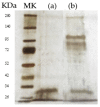Purification and Characterization of WA18, a New Mycocin Produced by Wickerhamomyces anomalus Active in Wine Against Brettanomyces bruxellensis Spoilage Yeasts
- PMID: 33379214
- PMCID: PMC7824415
- DOI: 10.3390/microorganisms9010056
Purification and Characterization of WA18, a New Mycocin Produced by Wickerhamomyces anomalus Active in Wine Against Brettanomyces bruxellensis Spoilage Yeasts
Abstract
Wickerhamomyces anomalus strain 18, isolated from a natural underground cheese ripening pit, secretes a mycocin named WA18 that inhibits wine spoilage yeasts belonging to Brettanomyces bruxellensis species, with a broad-spectrum of activity. WA18 was purified, and the purified protein was digested with specific restriction enzymes (lysine K and arginine R cut sites). The LC-MS and LC-MS/MS analysis after enzymatic digestions revealed a molecular weight of 31 kDa. Bioinformatics processing and database research of digested pure killer protein showed 99% identity with a UDP-glycosyltransferase protein. Competitive inhibition assay of killer activity by cell-wall polysaccharides suggests that branched glucans represent the first receptor site of the toxin on the envelope of the sensitive target. The WA18 partially purified crude extract (PPCE) showed high stability of antimicrobial activity at the physicochemical conditions suitable for the winemaking process. Indeed, in wine WA18 was able to counteract B. bruxellensis and control the production of ethyl phenols. In addition, the strain WA18 was compatible with Saccharomyces cerevisiae in co-culture conditions with a potential application together with commercial starter cultures. These data suggest that WA18 mycocin is a promising biocontrol agent against spoilage yeasts in winemaking, particularly during wine storage.
Keywords: Wickerhamomyces anomalus; bioactive yeasts; biocontrol; killer toxin; killer yeasts; spoilage yeasts.
Conflict of interest statement
The authors do not have financial and/or personal conflicts of interest regarding the study reported in the present manuscript.
Figures




Similar articles
-
Purification and characterization of Saccharomyces eubayanus killer toxin: Biocontrol effectiveness against wine spoilage yeasts.Int J Food Microbiol. 2020 Oct 16;331:108714. doi: 10.1016/j.ijfoodmicro.2020.108714. Epub 2020 Jun 5. Int J Food Microbiol. 2020. PMID: 32544792
-
Ustilago maydis killer toxin as a new tool for the biocontrol of the wine spoilage yeast Brettanomyces bruxellensis.Int J Food Microbiol. 2011 Jan 31;145(1):147-54. doi: 10.1016/j.ijfoodmicro.2010.12.005. Epub 2010 Dec 13. Int J Food Microbiol. 2011. PMID: 21195497
-
Comparative Zymocidial Effect of Three Different Killer Toxins against Brettanomyces bruxellensis Spoilage Yeasts.Int J Mol Sci. 2023 Jan 9;24(2):1309. doi: 10.3390/ijms24021309. Int J Mol Sci. 2023. PMID: 36674823 Free PMC article.
-
Brettanomyces bruxellensis yeasts: impact on wine and winemaking.World J Microbiol Biotechnol. 2017 Sep 21;33(10):180. doi: 10.1007/s11274-017-2345-z. World J Microbiol Biotechnol. 2017. PMID: 28936776 Review.
-
Starter cultures as biocontrol strategy to prevent Brettanomyces bruxellensis proliferation in wine.Appl Microbiol Biotechnol. 2018 Jan;102(2):569-576. doi: 10.1007/s00253-017-8666-x. Epub 2017 Nov 30. Appl Microbiol Biotechnol. 2018. PMID: 29189899 Free PMC article. Review.
Cited by
-
Yeast Interactions and Molecular Mechanisms in Wine Fermentation: A Comprehensive Review.Int J Mol Sci. 2021 Jul 20;22(14):7754. doi: 10.3390/ijms22147754. Int J Mol Sci. 2021. PMID: 34299371 Free PMC article. Review.
-
Metschnikowia pulcherrima and Lachancea thermotolerans Killer Toxins: Contribution to Must Bioprotection.Foods. 2025 Apr 23;14(9):1462. doi: 10.3390/foods14091462. Foods. 2025. PMID: 40361544 Free PMC article.
-
New Insights into the Production of Assyrtiko Wines from the Volcanic Terroir of Santorini Island Using Lachancea thermotolerans.Microorganisms. 2024 Apr 12;12(4):786. doi: 10.3390/microorganisms12040786. Microorganisms. 2024. PMID: 38674730 Free PMC article.
-
Analysis of the ethanol stress response mechanism in Wickerhamomyces anomalus based on transcriptomics and metabolomics approaches.BMC Microbiol. 2022 Nov 15;22(1):275. doi: 10.1186/s12866-022-02691-y. BMC Microbiol. 2022. PMID: 36380285 Free PMC article.
-
Microbial Biocontrol in the Agri-Food Industry.Microorganisms. 2023 Feb 21;11(3):552. doi: 10.3390/microorganisms11030552. Microorganisms. 2023. PMID: 36985126 Free PMC article.
References
-
- São-José C., Santos M.A., Schmitt M.J. Biology of Microorganisms on Grapes, in Must and in Wine. Springer; Cham, Switzerland: 2017. Viruses of wine-associated yeasts and bacteria; pp. 133–154.
-
- Klassen R., Schaffrath R., Buzzini P., Ganter P.F. Yeasts in Natural Ecosystems: Ecology. Springer; Cham, Switzerland: 2017. Antagonistic interactions and killer yeasts; pp. 229–275.
-
- Schaffrath R., Meinhardt F., Klassen R. Physiology and Genetics. Springer; Cham, Switzerland: 2018. Yeast killer toxins: Fundamentals and applications; pp. 87–118.
LinkOut - more resources
Full Text Sources
Molecular Biology Databases

